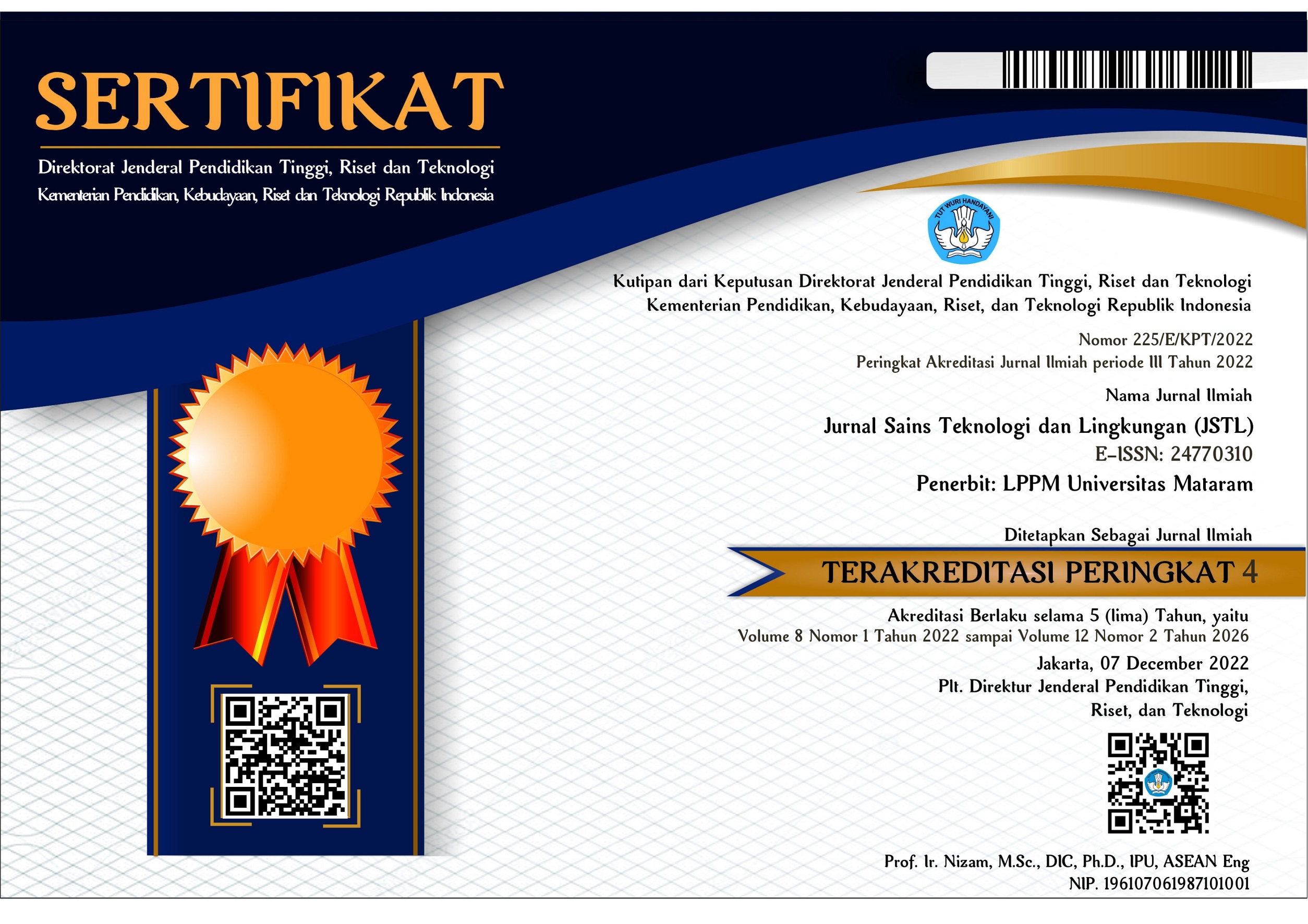Pengaruh Sistem Drainase Berwawasan Lingkungan terhadap Debit Limpasan pada Daerah Penyangga Kota Mataram
The Effect of an Environmentally Drainage System on Runoff Discharge in the Buffer Area of Mataram City
DOI:
https://doi.org/10.29303/jstl.v9i3.557Keywords:
runoff discharge, infiltration wells, increased runoffAbstract
Mataram as the capital of West Nusa Tenggara Province has attracted people to live in it. The small city of Mataram makes the surrounding area a buffer area for rapid development. This condition can be seen from the increase in housing around Mataram City. This increase in housing area causes a reduction in water catchment areas. So during the rainy season there is an increase in runoff. The aim of the research is to determine the effect of an environmentally friendly drainage system on the amount of runoff discharge. The data required is land use data, rainfall, location maps and soil data. Rainfall data is used for Intensity Duration Frequency (IDF) analysis. IDF curves and land use data are used for runoff discharge analysis. Soil data is used to determine permeability which is used to determine of the discharge of infiltration well. Next, analyze the effectiveness of infiltration wells as an environmentally friendly drainage system. The results of the research show that there has been an increase in residential area over the last 10 years by 58% in Labuapi District, the southern part of Mataram City, 25% in Lingsar District and 29% in Gunungsari District, which is in the northern part of Mataram City. Changes in land use resulted in an increase in runoff discharge of 21% in Labuapi District, 8% in Lingsar District and 15% in Gunungsari District. An infiltration well with a diameter of 1 m and a depth of 1 m can absorb 1.13 m3 of water in the southern part and 1.21 m3 in the northern part of Mataram City. If every 100 m2 of residential area there is one infiltration well, then the effectiveness of the infiltration well in reducing flood runoff is 17.71% in Labuapi District, 15.61% in Lingsar District and 23.35% in Gunungsari District.References
Nisumanti, S. (2017). Analisis Kebutuhan Sumur Resapan Sebagai Pencegahan Limpasan Air Hujan Pada Perumahan PUSRI Sembawa Banyuasin. Jurnal Tekno Global UIGM Fakultas Teknik, 6(2).
Pt-15-2002-C tentang Tata Cara Penerapan Drainase Berwawasan Lingkungan di Kawasan Pemukiman
Rurung, M. A., Riogilang, H., & Hendratta, L. A. (2019). Perencanaan sistem drainase berwawasan lingkungan dengan sumur resapan di lahan Perumahan Wenwin–Sea Tumpengan Kabupaten Minahasa. Jurnal Sipil Statik, 7(2).
SNI-03-2453-2002 tentang Tata Cara Perencanaan Teknik Sumur Resapan Air Hujan untuk Lahan Pekarangan
Sunjoto, S. 1988. Optimasi Sumur Resapan Air Hujan Sebagai Salah Satu Usaha Pencegahan Instrusi Air Laut. Yogyakarta: Fakultas Teknik Universitas Gadjah Mada
Supriyani, E., Bisri, M., & Dermawan, V. (2012). Studi Pengembangan Sistem Drainase Perkotaan Berwawasan Lingkungan (Studi Kasus Sub Sistem Drainase Magersari Kota Mojokerto). Jurnal Teknik Pengairan: Journal of Water Resources Engineering, 3(2), 112-121.
Suripin. 2004. Sistem Drainase Perkotaan yang Berkelanjutan. Yogyakarta: ANDI.
Syarifudin, A. (2017). Drainase Perkotaan Berwawasan Lingkungan. Penerbit Andi.
Wahyunto (Dalam Tinjauan Pustaka Universitas Sumatra Utara). 2001. Pengertian Alih Fungsi Lahan. UNSU
Yasa, I. W., Soekarno, S., & Negara, I. D. G. J. (2020). Efek Sumur Resapan Terhadap Pengurangan Volume Limpasan Permukaan. Jurnal Ganec Swara, 14(1), 537-543.
Downloads
Published
Issue
Section
License

This work is licensed under a Creative Commons Attribution-NonCommercial-ShareAlike 4.0 International License.



1.png)











